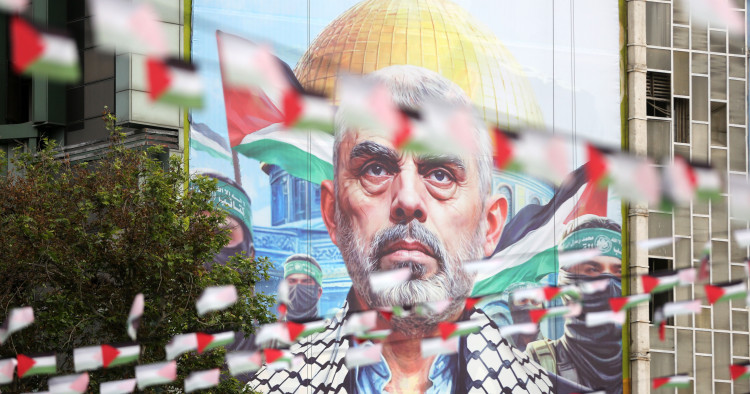Contents:
- Despite Sinwar’s death, no end in sight for Gaza war
- Sinwar’s death will do little to extinguish the flames engulfing the region
- No signs of policy shifts by Netanyahu following Sinwar’s killing
- Many obstacles prevent negotiated resolutions to wars in Gaza, Lebanon
- US Secretary of State Blinken tries Middle East diplomacy again at a time of war
- Post-Sinwar or pre-Iran-strike: A region awaits
Despite Sinwar’s death, no end in sight for Gaza war
Khaled Elgindy
Senior Fellow, Director of Program on Palestine and Palestinian-Israeli Affairs

-
The extent to which Yahya Sinwar’s death can be leveraged to bring about a cease-fire will depend on the Biden administration and whether it is actually prepared to apply meaningful and public pressure on the Netanyahu government, something it has thus far refused to do.
-
Sinwar may be succeeded by one of the exiled Hamas leaders based in Qatar, who have proven more flexible toward a cease-fire; but these individuals may have limited access to and influence over operational decisions inside Gaza.
The death of Hamas leader Yahya Sinwar, who was killed while battling Israeli soldiers in the southern Gaza town of Rafah last Wednesday, is a potential inflection point in the now year-long war that has seen at least 42,000 Palestinians killed and most of the Gaza Strip reduced to rubble. As the architect of the Oct. 7 attack and the ultimate arbiter over whether and when to accept a cease-fire, Sinwar’s death represents a major accomplishment for Israel’s military, which has racked up numerous tactical victories but has so far failed to achieve a decisive victory over Hamas. Both US and Israeli leaders have cast Sinwar as the primary obstacle to a cease-fire and hostage release deal, which has been stalled for many weeks.
Many, including President Joe Biden, view Sinwar’s death as an opportunity for Israel to declare victory and bring an end to the war. However, this assumes that Prime Minister Benjamin Netanyahu’s government is actually interested in a cease-fire or some kind of off ramp from the war in Gaza, for which there is very little evidence. Indeed, in the wake of Sinwar’s death, Netanyahu has said the war will continue, even as Israeli forces have intensified the siege and bombardment of northern Gaza, particularly in the Jabalia refugee camp. Moreover, the Israeli prime minister, who is widely understood to favor prolonged conflict as a means of staying in power, has consistently sought to escalate and expand the war, through assassinations, the bombardment and invasion of Lebanon, and, most recently, the intensified siege/bombing/starvation campaign in northern Gaza. Rather than end the war, Netanyahu may be more likely to see Sinwar’s death as an opportunity to “finish the job,” much as he did following the assassination of Hezbollah chief Hassan Nasrallah in Lebanon. The extent to which Sinwar’s death can be leveraged to bring about a cease-fire will depend on the Biden administration and whether it is actually prepared to apply meaningful and public pressure on the Netanyahu government, something it has thus far refused to do.
Meanwhile, it is unclear who will eventually succeed Sinwar, though the job is likely to fall to one of the exiled Hamas leaders based in Qatar; control over Hamas’s military wing in Gaza, however, is likely to remain with Mohammed Sinwar, the brother of the slain Hamas leader. On one hand, the shift in leadership could make a deal more achievable as the Doha leadership is known by and large to be more flexible than Sinwar. On the other hand, the outside leadership may have limited access to and influence over operational decisions inside Gaza.
Follow: @elgindy_
Sinwar’s death will do little to extinguish the flames engulfing the region
Charles Lister
Senior Fellow, Director of Syria and Countering Terrorism & Extremism programs

-
Hamas leader Yahya Sinwar’s death will bring solace to many and offers a window past the last year of debilitating conflict, but it will also increase the complexity and uncertainty around both conflict and diplomacy dynamics.
-
The brutality with which the war has been fought and the extraordinary toll it has taken have created conditions in Gaza in which Sinwar’s ultra-hardline stance is likely to become the norm, fueling long-term Hamas recruitment.
The death of Hamas leader Yahya Sinwar is a hugely significant development, but not necessarily one that paves the way toward ending the war in Gaza or bringing calm to the Middle East at large. As the architect of the Oct. 7 attack and the Hamas decision-maker with the final say on hostage and cease-fire talks, Sinwar’s death will bring solace to many and offers a window past the last year of debilitating conflict, but it also muddies the waters significantly — inserting a greater level of complexity and uncertainty into both conflict and diplomacy dynamics. The hostage file in particular now faces a far deeper challenge, as it was Sinwar alone who allegedly managed their locations, provision, and ultimately, their fate.
While Sinwar’s replacement remains unclear, the influence of Hamas’ politicos abroad is likely to increase in the interim. This includes Khaled Meshaal in Doha, whose stance in support of Syria’s revolution placed him in conflict with Iran’s influence within Hamas; and Khalil al-Hayya, also in Doha, who has coordinated much of the negotiations since October 2023. It is possible that Hamas will choose not to publicize Sinwar’s replacement, but that would only minimally affect the practicalities, given the movement’s long-standing use of a “collective leadership” model spanning between Gaza, the West Bank (led by Zaher Jabareen), Lebanon, and regional offices in Qatar, Turkey, and elsewhere. On the ground, the military fight will remain decentralized, with Sinwar’s brother Mohammed continuing his prior role in commanding operations.
While diplomatic efforts surge, little else is likely to change in Gaza. That Sinwar was killed above ground in conditions Hamas can present as “in combat” and “on the battlefield” will offer the group and its supporters an invaluable propaganda tool to sustain the fight. The brutality with which the war in Gaza has been fought and the extraordinary death and destruction wrought upon the coastal strip have also created conditions in which Sinwar’s ultra-hardline stance is likely to become the norm on the ground. Whatever the fate of ongoing diplomacy, Gaza’s reduction to rubble will fuel long-term Hamas recruitment just as Sinwar likely hoped.
Zooming out beyond Gaza, the regional hostilities and tensions show no sign of abating — and Sinwar’s death does little if anything to change that. Since Israel launched military operations inside Lebanon, the long-standing assumption that a Gaza cease-fire would bring regional calm no longer holds. That deal now needs to include Lebanon, which explains why Amos Hochstein, President Joe Biden’s special envoy, is in Beirut for talks. But Hochstein’s challenge is far greater today than it was three months ago. In this sense, perhaps Sinwar’s greatest legacy is the flames that now engulf so much of the wider region.
Follow: @Charles_Lister
No signs of policy shifts by Netanyahu following Sinwar’s killing
Nimrod Goren
Senior Fellow for Israeli Affairs

-
Shortly after the Israeli killing of Hamas leader Yahya Sinwar, senior US officials voiced hopes that it could create an opportunity to end the war in Gaza and release the hostages held by Hamas.
-
Israeli Prime Minister Benjamin Netanyahu, however, quickly indicated that Israel will continue fighting Hamas and has not shown any flexibility that could enable a cease-fire and hostage release deal.
There was a widespread sense of satisfaction in Israel after the news broke of the killing of Hamas leader Yahya Sinwar, the architect of the Oct. 7 terror attack. The general sentiment was that justice was finally done and Israel was now closer to destroying Hamas’ military and governing infrastructure.
There was also hope that this would enable the return of the 101 hostages still held by Hamas. After all, for months Israelis have been hearing from the US administration and their own government that Sinwar was the primary obstacle to a cease-fire and hostage release deal. With him now gone, could it pave the way toward such a deal?
The statements coming out from Washington were optimistic. “This moment gives us an opportunity to finally end the war in Gaza,” said Vice President Kamala Harris, the Democratic presidential nominee. Similar assessments were voiced by others, including President Joe Biden and Secretary of State Antony Blinken. Diplomatic moves followed, including a phone call between Biden and Israeli Prime Minister Benjamin Netanyahu, and the announcement of yet another trip by Blinken to the Middle East.
In Israel, US optimism was taken with a grain of salt. After all, throughout 2024, American public diplomacy regarding a possible deal was characterized by over-optimism, which time and again failed to deliver. Nevertheless, some in Israel shared these US sentiments. Hostage families claimed that “the main obstacle has been eliminated, it’s time for an immediate agreement to return all hostages.” Shin Bet chief Ronen Bar headed to Cairo to discuss an attempted revival of negotiations with his Egyptian counterpart; and in an Israeli security cabinet meeting, “new ideas were brought up to examine their feasibility for a hostage release proposal.”
But from Netanyahu’s side, there were no signs of a change in course. The Israeli prime minister, accused by many of repeatedly blocking opportunities to reach a deal, promised continued military action, as did his far-right coalition partners. “We will continue with full force until all your loved ones — our loved ones — are returned home,” he told hostage families. In parallel, the Israel Defense Forces (IDF) stepped up military operations in the northern Gaza Strip and Netanyahu’s Likud party issued an invitation to an event titled “Preparing to Settle Gaza.” Moves like these do not suggest that a deal to end the war is any closer — quite the opposite, in fact.
With that being the case, Israeli hopes for a hostage release shifted in a different direction. Perhaps post-Sinwar chaos and confusion in Gaza could lead to new intelligence enabling the IDF to locate and rescue the hostages? Or maybe Gazans holding the hostages might set them free now that Sinwar is dead, in return for financial rewards, immunity, and safe passage? Messages along these lines were voiced by Netanyahu, opposition leader Yair Lapid, and other public figures. An Israeli businessman even offered $100,000 to anyone in Gaza who releases a living Israeli hostage.
To date, this has not yielded any visible results, while the public and diplomatic focus has already moved on. The expected Israeli retaliation against Iran and the US presidential election are both drawing near, shifting attention — once again — away from the fate of the hostages and efforts to end the war in Gaza.
Follow: @GorenNimrod
Many obstacles prevent negotiated resolutions to wars in Gaza, Lebanon
Randa Slim
Senior Fellow and Director of Conflict Resolution and Track II Dialogues Program

-
The problem with efforts to end the wars in Gaza and Lebanon is that neither can Israel achieve a total military victory nor are Hamas and Hezbollah willing to surrender to Israel’s terms.
-
Adding to this complex picture is a potential Israeli-Iranian war, which would throw up another set of obstacles to cease-fire deals in Gaza and Lebanon.
Ahead of a potential major escalation in the Israeli-Iranian conflict, US officials are heading to the Middle East to push forward two cease-fire deals — one between Hamas and Israel and the other between Lebanese Hezbollah and Israel. In both conflict theaters, Israeli Prime Minister Benjamin Netanyahu feels he is on a winning streak after the decapitation of the two organizations’ senior leaders, the last one being Hamas’ head, Yahya Sinwar. Absent serious and credible US pressure, like imposing an arms embargo on Israel, Netanyahu, buoyed by the latest uptick in his public opinion polling, will not change his calculus. Having fully adopted the mantle of a war prime minister, he will persist with his mission to change “the strategic reality in the Middle East.”
In both conflict situations, there are reference points for a negotiated deal. In Gaza, it is the plan laid out on May 31 by President Joe Biden. In Lebanon, it is United Nations Security Council Resolution 1701, which was passed in 2006 to end another Israel-Lebanon war. The problem lies in the fact that neither can Israel achieve a total military victory nor are Hamas and Hezbollah willing to surrender to Israel’s terms. On one side, Israel wants to dictate the terms of the end state in Gaza and Lebanon. On the other side, Hamas and Hezbollah are engaging in an existential fight whose objective is to deny Israeli officials their war aims and force them to sustain cumulative losses. This is a recipe for a never-ending insurgency against what some senior Israeli ministers are already alluding to — a reoccupation of Gaza, the construction of settlements there, as well as the establishment and occupation of a buffer zone between the Blue Line and the Litani River in southern Lebanon.
Another complicating factor in negotiating these cease-fire deals in Gaza and Lebanon is that it is not clear who speaks respectively for Hamas and Hezbollah or who can deliver their fighters to back a negotiated deal that would include the release of Israeli hostages in Gaza and an end to the firing of rockets into northern Israel. By decapitating the Gaza-based Hamas leadership, including Yahya Sinwar, and Hezbollah’s political and military leadership, including Secretary-General Hassan Nasrallah, Israeli leaders have increased rather than removed the obstacles to a negotiated deal in either situation. The decision-making process inside each organization has become decentralized and the chain of command disrupted, likely giving rise to multiple competing leadership nodes in both of them, some of which will be resistant to a negotiated deal.
Adding to this complex picture is a potential Israeli-Iranian war, which would throw up another set of obstacles to cease-fire deals in Gaza and Lebanon. Both Hamas and Hezbollah will likely be emboldened rather than deterred by an escalation in that conflict space. Netanyahu undoubtedly believes in his mission of reshaping the Middle East. But the Middle East has a long record of denying Israeli prime ministers their ambitions.
Follow: @rmslim
US Secretary of State Blinken tries Middle East diplomacy again at a time of war
Brian Katulis
Senior Fellow for US Foreign Policy

-
US Secretary of State Antony Blinken’s 11th trip to the Middle East since Oct. 7, 2023, is focused once again on cease-fires and a hostage-release deal as wars continue in Gaza and Lebanon.
-
With the threat of an Israeli military strike against Iran looming, it remains to be seen whether these diplomatic efforts will bear fruit.
US Secretary of State Antony Blinken is traveling to the Middle East at the start of this week, heading first to Israel and then to other regional capitals not yet announced. The main goal of Blinken’s 11th trip to the region since the start of the Israel-Hamas war a year ago, according to the State Department release, is the same one as his previous trips: achieving a cease-fire and hostage release in Gaza. But also on the list this time is a cessation of hostilities between Israel and Hezbollah in Lebanon.
On the day of Blinken’s departure, the State Department website has an urgent notice in red at the top stating, “U.S. Citizens in Lebanon: We continue to advise that U.S. citizens depart Lebanon due to the unpredictable nature of ongoing conflict between Hizballah and Israel and recent explosions throughout Lebanon, including Beirut.”
Last week’s killing of Hamas leader Yahya Sinwar led some Biden administration officials to raise the prospect that this could be a turning point in the war and create an opening for diplomacy, as was discussed at a recent Middle East Institute webinar. But Israel seems more focused on using military means, rather than diplomacy. Hamas and Hezbollah also seem poised to continue fighting — and America’s direct leverage over these terrorist groups is much more limited.
The last time Blinken was in the region was just days before an Israeli airstrike killed Hezbollah leader Hassan Nasrallah. With Israel threatening to strike against Iran soon, in retaliation for its ballistic missile attack earlier this month, it remains to be seen whether Blinken’s diplomatic efforts will bear fruit.
The Biden administration’s approach to the Middle East is challenged by multiple factors, but the main one is this: wars driven by actors that see themselves in an existential fight are difficult to end with diplomacy, especially if that diplomacy is disconnected from security dynamics on the ground. Think back to the first year of the Biden administration, when it was still engaged in diplomatic efforts in Doha with the Taliban just as Taliban forces were sweeping across the country, taking control of communities and ultimately the government.
As a result, the Biden administration’s track record on achieving its Middle East policy objectives over the past year, including securing the release of hostages and bringing an end to hostilities, is poor.
What steps can the Biden team take to increase the chances for more positive outcomes in its diplomacy?
- Synchronize US military and security cooperation moves with its diplomacy. US diplomacy is most successful when it is conducted in an environment that increases, rather than decreases, stability and security. Currently, US policy in the Middle East remains reactive to attacks by Iran and its network of partners in the region, and US counter-responses are carefully calibrated with an eye to preventing escalation rather than producing the deterrence necessary to achieve desirable diplomatic end states.
- Strengthen US coordination with key partners in the region, especially on post-war planning. Blinken’s rounds of diplomacy in the Middle East over the past year have come up short for a number of reasons, but one reason is that they have failed to create greater synergy between America’s key partners in the region, particularly the Arab partners like Jordan, Egypt, and key Gulf states, that actually share two main end goals of US policy: creating an eventual State of Palestine and avoiding a regional war with Iran.
- Double down on US engagement in the Middle East. The Biden administration has less than three months to go in office, and it should use this time to improve the situation in the Middle East. There seems little prospect that things will look better in the region than when it entered office, but it should at least seek modest improvements that set up the next administration for a better chance to produce greater security. This means that the Biden team will need to spend more time in the region, which is a quite different posture than it had when it entered office.
Blinken’s 11th trip to the Middle East is unlikely to produce major outcomes, but if he enhances cooperation with key partners, especially those Arab countries that share similar goals to the United States, he can set Biden’s successor up for a better situation than currently exists in the region.
Follow: @Katulis
Post-Sinwar or pre-Iran-strike: A region awaits
Paul Salem
Vice President for International Engagement

-
The killing of Yahya Sinwar strengthens Prime Minister Benjamin Netanyahu’s hand and bolsters his momentum to take the war from Iranian allies or proxies to Iran itself.
-
The Iranian leadership could choose to read the Israeli strike as proportionate and choose not to respond with further retaliation or escalation; or it might have to decide whether to move toward large-scale war with Israel and the US or resort to urgent diplomacy to avoid that slide to war.
The Middle East region is not so much in a post-Sinwar but in a pre-Iran-strike moment. The killing of Hamas leader Yahya Sinwar is not a game changer per se. It weakens Hamas further but does not necessarily alter the chances for a hostage release, a cease-fire, or an end to the fighting in Gaza. Nor will it alter Israel’s second front campaign against Hezbollah in Lebanon. The killing of Sinwar strengthens Prime Minister Benjamin Netanyahu’s hand — after the killing of Hezbollah leader Hassan Nasrallah in Lebanon — and bolsters his momentum to take the war from Iranian allies or proxies to Iran itself. How the strike on Iran unfolds, and what dynamic of escalation — or de-escalation — it unleashes will determine the course of events in the region and the global economy for the weeks and months to come.
Among governments in the region, there was little love lost for Hamas or its leader, nor for his unleashing of this latest round of devastating conflict. Among populations, there is widespread sympathy for the suffering of Palestinians; and for many, Sinwar died fighting for a Palestinian cause that they sympathize with.
There are a few possible outcomes for the upcoming Israeli strike on Iran and its aftermath. In one scenario, Israel implements a significant but limited strike, and Iran chooses to read the strike as proportionate and decides to absorb the blow without further retaliation or escalation. In a second scenario, the Israeli strike is larger than the Iranian leadership can absorb or overlook.
Here Iran’s leaders would have a strategic decision to make: either A) to move toward large-scale war with Israel and the US, or B) to resort to urgent diplomacy to avoid that slide to war. In the case of option “A,” there are also several possibilities: A1) Iran is able to inflict enough damage on Israel and Israelis in its own retaliatory strike to deter further Israeli escalation, and the war reaches a precarious mutually deterred cease-fire; A2) Iran, like Hezbollah before it, is unable to cause large-scale harm in Israel, does not have real deterrence, and Israel is unleashed to inflict widespread damage on the Islamic Republic’s institutions and infrastructure; or A3) Iran, unable to deter Israel directly, turns its sights on the soft target that would certainly get America’s attention, if not Israel’s — the energy production and transport assets of America’s partners in the Gulf Cooperation Council (GCC). The GCC countries have been smothering Iran in a warm embrace — much like a vulnerable boxer hugs his dangerous opponent — to make it more difficult for Tehran to pivot and throw punches in their direction; but it’s not clear if that strategy will work.
In option “B,” the leadership in Iran decides it faces a moment of existential peril and that a wider war will make matters worse. In that case, Iran could take an approach of radical diplomacy, offering significant concessions in Lebanon and Gaza and, more importantly, extending significant concessions to the US and the international community on the nuclear and potentially other files. This scenario might appear far-fetched given the bravado of the past years, but Iran’s leaders value regime survival over all else. They’ve been happy to fight to the last Arab but might be less willing to take losses at home. Some fancy diplomatic footwork, if it blunts Netanyahu’s war, might avoid the worst and enable the Iranian leadership to buy time and figure out a fresh way forward in the years ahead.
Follow: @paul_salem
Photo by Fatemeh Bahrami/Anadolu via Getty Images
The Middle East Institute (MEI) is an independent, non-partisan, non-for-profit, educational organization. It does not engage in advocacy and its scholars’ opinions are their own. MEI welcomes financial donations, but retains sole editorial control over its work and its publications reflect only the authors’ views. For a listing of MEI donors, please click here.













